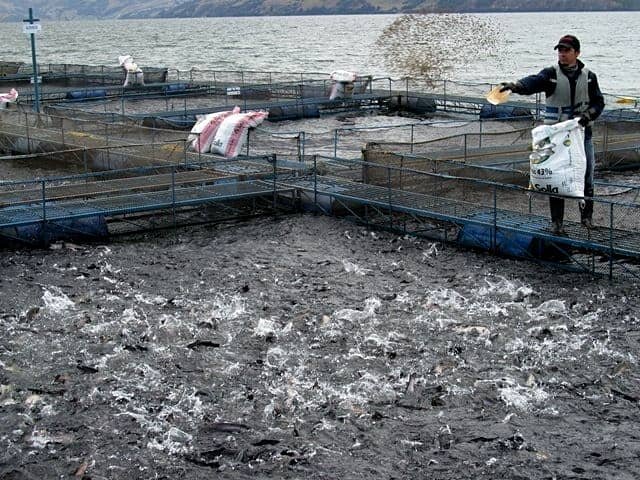
The flourishing aquaculture industry faces a silent enemy: aflatoxins. These toxins, produced by harmful fungi, contaminate fish feed and pose a significant threat to fish health and, ultimately, human consumers.
The World Health Organization and the Food and Agriculture Organization (FAO) are rightly concerned about aflatoxins in food. These toxins, particularly aflatoxin B1 (AFB1), are potent carcinogens, damage DNA, and cause cancer in humans and animals.
A team of scientists from the University of Mato Grosso do Sul (Brazil) published a scientific review aimed at analyzing recent studies focused on the use of bentonite clays as adsorbent materials for mycotoxins in fish feed, particularly in tilapia feed.
The challenge of mycotoxins in aquaculture
Aflatoxins, particularly AFB1, are the most concerning mycotoxins found in fish feed. They are produced by fungi such as Aspergillus flavus and Aspergillus parasiticus, and can contaminate various ingredients like soybean meal and cereals commonly used in aquaculture. Thus, fish feed itself can become a breeding ground for harmful mycotoxins.
Mycotoxin contamination not only affects the health and growth of fish but can also bioaccumulate and reach human consumers through fish contaminated by these mycotoxins.
Bentonite clays: a natural defense
Bentonite clays, primarily composed of montmorillonite, offer a promising solution. These natural clays act as adsorbents, attracting and binding mycotoxins within the digestive system, effectively reducing their harmful effects.
Several studies have shed light on the potential of bentonite clays. Research on Nile tilapia (Oreochromis niloticus) showed a decrease in residual aflatoxin levels when treated with ozone and supplemented with bentonite clay in their diet. This suggests that bentonite clays can effectively detoxify fish feed and improve fish health.
Scientific evidence of bentonite clay efficacy
Researchers reviewed extensive databases such as Cochrane, Science Direct, PubMed, and Scopus, analyzing 1,878 publications from the last decade.
Stay Always Informed
Join our communities to instantly receive the most important news, reports, and analysis from the aquaculture industry.
After meticulous evaluation, seven key studies emerged. These studies focused on the use of bentonite clays as “adsorbents,” essentially sponges that absorb mycotoxins from fish feed.
The findings are encouraging.
Fish exposed to aflatoxin B1, a potent mycotoxin, showed altered blood parameters, indicating compromised health. However, the studies also revealed a positive side: supplementation with bentonite clay significantly reduced the adverse effects of aflatoxin B1.
The good news is that bentonite clays appear to be a promising solution. Studies suggest that adding these clays to fish feed can significantly reduce the effects of aflatoxicosis, a condition caused by aflatoxin B1.
Here’s how it could benefit the fish:
- Better weight gain: Bentonite can help fish maintain healthy weight gain despite mycotoxin contamination.
- Improved immunity: Studies suggest positive changes in serum enzymes related to the fish’s humoral immune system, indicating possible immune support.
- Reduced tissue damage: Bentonite can help mitigate damage caused by aflatoxin B1 in vital organs such as gills and liver.
The case for adopting bentonite clay in aquaculture
Research shows a clear picture: aflatoxin B1 contamination in fish diets, particularly tilapia, poses a significant threat to fish health and, ultimately, public health. Bentonite clays, on the other hand, demonstrate immense potential to mitigate these risks. By binding and eliminating mycotoxins, they offer a natural and cost-effective detoxification approach for the aquaculture industry.
Conclusion
Aflatoxins pose a significant threat to the sustainability and safety of aquaculture. However, bentonite clays offer a natural and potentially cost-effective solution to combat mycotoxins in fish farming. This can ensure fish health, improve the economic production of fish farms, and ultimately contribute to making aquaculture products safer for consumers.
“According to the studies, bentonite clays reduce the effects of aflatoxicosis in terms of body weight, serum enzyme indicators, humoral immunity, gill morphology, and bioaccumulation in the liver and muscle of tilapia,” the scientists conclude.
While current research is promising, more studies are needed to fully understand the long-term effects of bentonite clay on various fish species and to optimize its application in different aquaculture environments. However, the evidence suggests that bentonite clays are immensely promising for safeguarding the sustainability and safety of aquaculture.
The study was funded by the Federal University of Mato Grosso do Sul (UFMS), the Brazilian Research Council (CNPq), and the Coordination for the Improvement of Higher Education Personnel-Brazil (CAPES).
Contact
Valter Aragão do Nascimento
Group of Spectroscopy and Bioinformatics and Health School of Medicine Postgraduation Program in Health and Development in the Midwest Region Faculty of Medicine Federal University of Mato Grosso do Sul
Campo Grande Mato Grosso do Sul, Brazil
Email: aragao60@hotmail.com
Reference (open access)
Melo, P., Jacques Barbosa, A. M., Guimarães, C. A., Arunachalam, K., Oliveira, R. J., Pinheiro Lima, A. C., Gomes Rosa, A. C., Pereira Ancel, M. A., & Saldanha Tschinkel, P. F. (2024). Bentonite Clays as Adsorbent Material for Mycotoxins and the Hematological Parameters Involved in Tilapia Species: A Systematic Review. Aquaculture Research, 2024(1), 4899256. https://doi.org/10.1155/2024/4899256
Editor at the digital magazine AquaHoy. He holds a degree in Aquaculture Biology from the National University of Santa (UNS) and a Master’s degree in Science and Innovation Management from the Polytechnic University of Valencia, with postgraduate diplomas in Business Innovation and Innovation Management. He possesses extensive experience in the aquaculture and fisheries sector, having led the Fisheries Innovation Unit of the National Program for Innovation in Fisheries and Aquaculture (PNIPA). He has served as a senior consultant in technology watch, an innovation project formulator and advisor, and a lecturer at UNS. He is a member of the Peruvian College of Biologists and was recognized by the World Aquaculture Society (WAS) in 2016 for his contribution to aquaculture.



